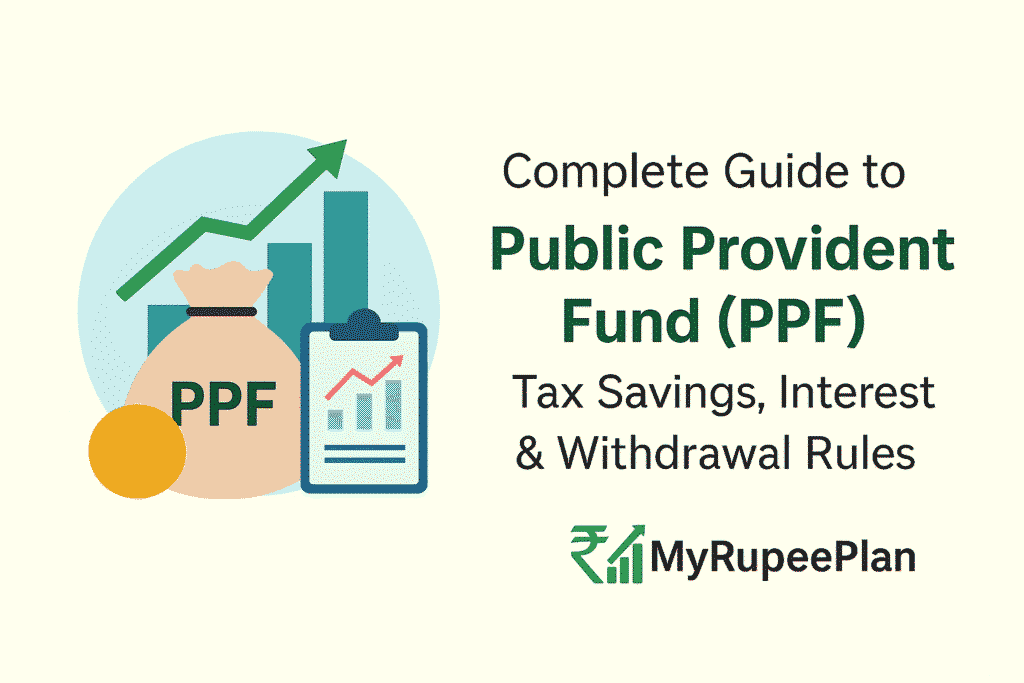Complete Guide to Public Provident Fund (PPF): Tax Savings, Interest & Withdrawal Rules
What is Public Provident Fund (PPF)?
The Public Provident Fund (PPF) is a long-term savings scheme launched by the Government of India in 1968. It was introduced to encourage people to save small amounts regularly and build a secure corpus over time.
One of the biggest advantages of PPF is that it offers guaranteed, tax-free returns, making it an excellent choice for conservative investors.
Why is a PPF Account So Important?
A PPF account isn’t just a savings tool — it’s a powerful financial safety net. Here’s why it’s so important:
- Safe & Government-backed: Your money is fully secured as it’s backed by the central government.
- Tax benefits: Contributions are eligible for tax deductions under Section 80C, and interest earned is tax-free.
- Long-term wealth creation: Over 15 years (and beyond), small contributions can grow into a substantial corpus thanks to compounding.
Features & Benefits of a PPF Account
✅ Tenure: 15 years (with options to extend in 5-year blocks)
✅ Interest Rate: Currently around 7.1% p.a., revised quarterly by the government
✅ Minimum Investment: ₹500 per year
✅ Maximum Investment: ₹1.5 lakh per year
✅ Tax Benefits: EEE (Exempt-Exempt-Exempt) status — tax-free on investment, interest, and maturity
✅ Partial Withdrawals: Allowed from the 7th year onwards
✅ Loan Facility: Available between the 3rd and 6th year
How to Open a PPF Account
You can open a PPF account both online and offline.
Offline
- Visit your nearest post office or bank branch (SBI, ICICI, HDFC, etc.)
- Fill out the PPF account opening form
- Submit KYC documents and initial deposit
Online
- Log into your bank’s net banking
- Find the option to open a PPF account
- Fill in your details and submit
Documents Required for PPF
- Identity proof (Aadhaar, PAN, Voter ID)
- Address proof (utility bill, Aadhaar, etc.)
- Passport-size photograph
- PAN card (mandatory)
- Signature specimen (for offline applications)
Withdrawal Rules & Procedure
You can’t withdraw the entire amount before maturity (15 years), but partial withdrawals are allowed after the 6th financial year.
Partial Withdrawals: Up to 50% of the balance at the end of the 4th year or immediately preceding year, whichever is lower.
Full Withdrawal: Allowed after 15 years.
Premature Closure: Allowed after 5 years for specific cases like serious illness or higher education (with penalty on interest).
What are the Disadvantages of PPF?
❌ Lock-in period of 15 years (limits liquidity)
❌ Investment cap of ₹1.5 lakh per year
❌ Returns are moderate compared to equity mutual funds or stocks
❌ Not ideal for aggressive growth seekers
💬 Frequently Asked Questions (FAQs)
What is the eligibility for opening a PPF account?
Any Indian resident can open a PPF account. Minors can open one through a guardian.
What is the minimum and maximum deposit amount?
What is the tenure of a PPF account?
What is the current PPF interest rate?
Can I take a loan from my PPF?
Yes, between the 3rd and 6th financial years.
Can I withdraw before maturity?
Partial withdrawals are allowed after the 6th year; full withdrawal only after 15 years.
How much will ₹1,000 per month grow to in 15 years?
Roughly ₹2.5–₹3 lakh, depending on the interest rate.
Is PPF better than FD?
PPF offers better post-tax returns and tax benefits, but it has a longer lock-in.
Is PPF tax-free?
Yes, contributions, interest, and maturity amount are all tax-free.
Conclusion
PPF remains a solid choice for anyone looking for safe, long-term, and tax-free savings. With its guaranteed returns and tax advantages, it helps you build a retirement corpus or meet future financial goals without worrying about market volatility.
Start with small, regular contributions, and stay consistent — that’s the secret to big wealth via PPF!

